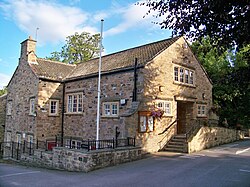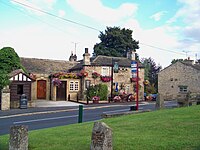Linton, Wetherby: Difference between revisions
Created page with '{{Infobox town |name=Linton |county=Yorkshire |riding=West |picture=Linton village hall.jpg |picture caption=Linton village hall |os grid ref=SE389468 |latitude=53.92 |longitude=…' |
m clean up, typos fixed: the the → the |
||
| Line 19: | Line 19: | ||
The village is to be found between [[Wetherby]] and [[Sicklinghall]], on the [[River Wharfe]]; Linton is on the north bank of the river and Collingham on the opposite bank, the two joinedby a bridge. | The village is to be found between [[Wetherby]] and [[Sicklinghall]], on the [[River Wharfe]]; Linton is on the north bank of the river and Collingham on the opposite bank, the two joinedby a bridge. | ||
Though separate from Wetherby, surrounded by countryside, the cottages of Linton stretch down | Though separate from Wetherby, surrounded by countryside, the cottages of Linton stretch down the road to its neighbour and meet those reaching up from Wetherby. | ||
==Name== | ==Name== | ||
| Line 35: | Line 35: | ||
A correspondent writing in the ''Leeds Mercury'' on 8 September 1874 notes: | A correspondent writing in the ''Leeds Mercury'' on 8 September 1874 notes: | ||
<blockquote>"On the opposite side of the Wharfe [from Collingham], perched on the hillside, is the picturesque village of Linton, the most conspicuous object being a neat Wesleyan chapel."<ref> [http://www.parlington.co.uk/locations.lasso?process=9&subProcess=local5 Parlington Hall]</ref></blockquote> | <blockquote>"On the opposite side of the Wharfe [from Collingham], perched on the hillside, is the picturesque village of Linton, the most conspicuous object being a neat Wesleyan chapel."<ref>[http://www.parlington.co.uk/locations.lasso?process=9&subProcess=local5 Parlington Hall]</ref></blockquote> | ||
According to ''Kelly's Directory'' of 1893, Linton had four farms, a school (founded about 1859, later a church and now a dwelling house), a manor house (c. 1650 but much altered), and a public house (''The Windmill Inn''). The population of Linton in the 1920s was only 130. | According to ''Kelly's Directory'' of 1893, Linton had four farms, a school (founded about 1859, later a church and now a dwelling house), a manor house (c. 1650 but much altered), and a public house (''The Windmill Inn''). The population of Linton in the 1920s was only 130. | ||
Latest revision as of 16:55, 29 January 2016
| Linton | |
| Yorkshire West Riding | |
|---|---|
 Linton village hall | |
| Location | |
| Grid reference: | SE389468 |
| Location: | 53°55’12"N, 1°24’36"W |
| Data | |
| Post town: | Wetherby |
| Postcode: | LS22 |
| Dialling code: | 01937 |
| Local Government | |
| Council: | Leeds |
| Parliamentary constituency: |
Elmet |
Linton is an affluent village a mile and a half southwest of Wetherby, in the West Riding of Yorkshire. It belongs to the parish of Collingham.
The village is to be found between Wetherby and Sicklinghall, on the River Wharfe; Linton is on the north bank of the river and Collingham on the opposite bank, the two joinedby a bridge.
Though separate from Wetherby, surrounded by countryside, the cottages of Linton stretch down the road to its neighbour and meet those reaching up from Wetherby.
Name
The name "Linton" is from the Old English lin tun, meaning "flax farm".
Another 'Linton' is to be found higher up the River Wharfe, in the Craven area of Yorkshire.
History
Crop marks around the village point to ditched enclosures and field systems in the Iron Age and Roman period (800 BC – AD 410). Roman artifacts have also been found, and in 1936, a Roman burial site was identified to the north of the village.
The village is mentioned in the Domesday Book, where it is valued higher than Wetherby. There was a now-vanished mediæval chapel in the village, possibly founded by the Percy family, who once owned the village.[1]
A Topographical Dictionary of England (1848, ed. Samuel Lewis) calls Linton:
"a township, in the parish of Spofforth, Upper division of the wapentake of Claro, W. riding of York, 1¾ mile (W. by S.) from Wetherby; containing 169 inhabitants. The township comprises by computation 1030 acres. The village is situated on the north side of the vale of the Wharfe. A rent-charge of £257. 10. has been awarded as a commutation for the tithes. There is a place of worship for Wesleyans."[2]
A correspondent writing in the Leeds Mercury on 8 September 1874 notes:
"On the opposite side of the Wharfe [from Collingham], perched on the hillside, is the picturesque village of Linton, the most conspicuous object being a neat Wesleyan chapel."[3]
According to Kelly's Directory of 1893, Linton had four farms, a school (founded about 1859, later a church and now a dwelling house), a manor house (c. 1650 but much altered), and a public house (The Windmill Inn). The population of Linton in the 1920s was only 130.
The golf course on Linton Ings was opened in 1910. The architect William Alban Jones was responsible for several new houses built in the Arts and Crafts Movement style around the old hub of the village in the 1920s, and also for the small Memorial Hall (1947).[4]
About the village

The village has one pub - the Windmill Inn on Main Street, which has a restaurant.[5] There is no shop or school. Wetherby golf club is situated in Linton. The historic Wood Hall Hotel and Spa is on the outskirts of the village; this has function rooms and health club facilities.[6] There is a guest house called Linton Close overlooking Linton Ings. The Memorial Hall has a car park and tennis courts.
Church
The village no longer has a place of worship. It forms part of the ecclesiastical parish of Wetherby with Linton, served by St James's Church in Wetherby.[7]
Outside links
| ("Wikimedia Commons" has material about Linton, Wetherby) |
References
- ↑ Linton Conservation Area Appraisal and Management Plan, Leeds City Council, 22 February 2010. Retrieved 23 September 2012.
- ↑ [1]
- ↑ Parlington Hall
- ↑ Parish of Collingham with Linton. Design Statement May 2010. Retrieved 22 September 2012.
- ↑ Yorkshire Escapes. Retrieved 22 September 2012.
- ↑ Yorkshire Life. Retrieved 22 September 2012.
- ↑ Church website. Retrieved 22 September 2012.
